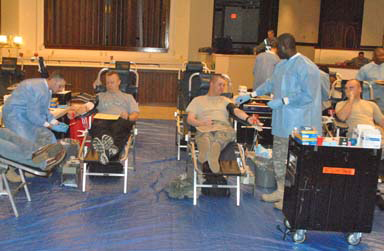Research that is in the red

According to the American Red Cross, every two seconds, someone in this country needs blood.
In an effort to improve the future of blood products, the Department of Defense, led by the U.S. Army Medical Research and Materiel Command, has established effective programs in the hopes of aiding both warfighters and civilians.
Since 1970, January has been designated National Blood Donor Month by the American Red Cross. This annual program was initiated to highlight the importance of blood donations not only in times of emergencies but also year-round. As donations typically drop off in January due to weather-related delays and travel concerns, the ARC is hoping to illustrate via its January drive that this seasonal decrease certainly does not reduce the need for blood products.
Approximately 44,000 blood donations are necessary each day to treat accident and burn victims, cancer patients, those having surgery, new mothers, premature babies, and many others. Donating blood is considered safe, and it takes less than an hour of time commitment from the donor.
Most people know someone who has received blood, and perhaps many more who have donated blood at some time. Once blood is donated by volunteers, the blood is processed in a way to produce various blood products such as red blood cells, platelets, fresh frozen plasma, and cryoprecipitate.
Since the blood product to be used, as well as the blood type, depends on each individual patient's need for blood replacement, maintaining a robust supply remains critical for meeting the needs of the general public. Having a limited shelf-life, blood products must constantly be replenished. By reaching out to more potential donors and explaining the need for their help, the ARC hopes that no one will be denied the healthcare they need on a moment's notice.
Needless to say, it goes far beyond a simple needle-stick to save a life.
The USAMRMC's research on Improved Blood Products falls under the broader Hemorrhage and Resuscitation Research and Development Program. The HRRDP has six major strategic efforts, and one of these focuses on developing safer and more logistically supportable blood products for transfusion. While this effort is primarily intended to help warfighters on the battlefield, the information gained from this research will also have applications in the civilian sector.
The goals for the Improved Blood Products Strategic Effort are to develop more logistically supportable blood products for transfusion, enhance the availability of blood products on the battlefield, develop means to improve the safety of blood products used on the battlefield, and examine selected issues related to the safety and efficacy of specific blood products. Selected DoD product development and research in this area include: (1) dried plasma to reduce logistical constraints associated with frozen plasma and expand the availability of plasma in military operations; (2) cryopreserved platelets that can be stored frozen for years (DoD is also investigating other approaches to improving platelet shelf-life); (3) an improved collection and storage system to increase battlefield shelf-life and improve the metabolic quality of red blood cells; (4) a pathogen reduction system for whole blood to provide pathogen-reduced blood products; (5) clinical studies examining the effects of red cell storage age on outcomes following transfusion in critical patients; (6) evaluation of the use of frozen versus liquid-stored red cells in a clinical trauma study; and (7) in vitro production of red blood cells that are universal donor and pathogen-free.
These research efforts, along with others, will help change the way that blood products are collected, stored, processed, and ultimately transfused. However, until researchers find a way to reduce the need for blood donations, the collection of blood must continue.
Remember, although January is National Blood Donor Month, blood collection is critical throughout the year. Please consider donating blood soon, as it could help save the life of someone you know.














